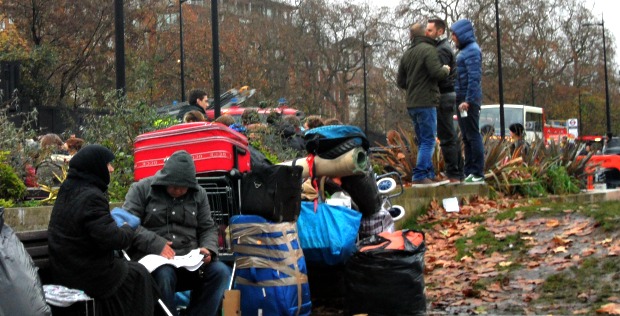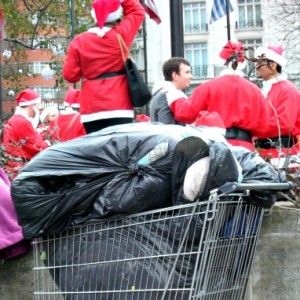You have no items in your cart. Want to get some nice things?
Go shopping
It’s a Saturday afternoon in December and Marble Arch is full of people dressed in Santa costumes. The island at the top of Park Lane has become a noisy red sea bobbing with foamy white beards. Drivers slow down, passers-by exclaim and tourists rush over to take photographs of the merry crowd. The revellers are part of Santacon, a yearly event. The idea, part flash mob, part pub crawl, originated in the US and has taken over in the UK. Today, the convention is sharing the square with another import, the Romany Gypsies who have chosen Marble Arch as their home since 2012. They cluster in small groups on wooden benches, close to their possessions – bags and suitcases crammed into shopping trollies. The women are dressed in long black garments, their heads covered in loose veils. The men wear thick hooded jackets and woollen caps against the misty cold. An old Gypsy woman approaches a youngster who is changing into his Father Christmas costume and dances around him. Her companions just chat among each other, ignoring the commotion.
I approach an old woman with crutches and a squat man muffled in a green hooded jacket. The woman speaks no English at all. With gestures, she tells me they’re hungry and that they want to go – or maybe she’s telling me to go away, who knows?
The man is a little chattier. He tells me they are from Romania. He finds London okay but sleeping outside is cold. He describes how each morning, the police descend on them.
“Every day, police ask us for ID. In the morning, one time, three times, always asking. We no steal. We just sitting there. We honest, you know?”
He mimes them sitting, arms crossed. He says he’s been in London for twenty days. When I ask him where in Romania he comes from he says he can’t understand me. Will the new laws in January mean he will come to London to live, I ask?
“No, I go back,” he says, frowning.
He then says I should come back with a Romanian translator as his English is limited. The woman is still talking to me in her language. She speaks volubly, peering at me through silver rimmed glasses, pointing at her stomach and miming the act of eating. I take my leave and walk away. The Santas are still doing their stuff, which is mostly drinking, cheering at regular intervals and using Marble Arch as a public lavatory. The young men have chosen a small wall to piss against in full view of everyone. The female Santas crouch, farther away under a tree.
The Romany Gypsies have been vilified all year for allegedly behaving in a similar way. The Santacon will be treated the next day with indulgence by the British press as a celebration of Christmas cheer. A few clashes with the police and their habit of relieving themselves all over central London are apparently forgiven. Not so with the Gypsies, who will probably wake to yet another police check.
There is something grand in the way this group of Romany Gypsies settled their makeshift camp in Park Lane. They chose one of the best London postcodes, something the Daily Mail was quick to point out, as though they were depriving someone else of the privilege. A group of purely English squatters, maybe, that was ogling the same spot? The press reported that Westminster Council was unable to evict the rough sleepers as they were generally not breaking immigration laws – Romanian nationals are allowed three-month visas to the UK. Much was made of the Gypsies’ unhygienic lifestyle, as though this was a symbol of their culture polluting the fragrant streets of Park Lane.

The attitude of the people working in Marble Arch seems hostile too. I spoke with Henrik, working for a large hotel in Marble Arch. He says that during the summer especially, the Gypsies used to come inside the hotel to beg from the customers, two or three of them around one customer, and that they tried to steal things.
“I am Hungarian and my mother is from Transylvania. These people make me ashamed. I am scared that English people will think that all Eastern Europeans are like that. But we have Gypsies in my country too and we don’t like them.”
He tells me of rumours he’s heard around Marble Arch that the beggars use Western Union to send all their money home, where they build villas and own Mercedes and BMW cars.
“In this country, everyone has an opportunity to find a job. They shouldn’t beg. If it was me, I would send them all home today.”
“Sending them home today” is the tactic that the French government adopted in 2010. This included mass expulsions of Romany Gypsies back to the Eastern European countries they came from. French interior minister Manuel Valls has recently said that “Romas could never integrate into French society,” a charge usually levelled in more discreet terms against French people of Maghrebi origin. This type of behaviour has led to a growing support movement in favour of the Roma Gypsies in France. In particular, the case of Leonarda, a 15-year old schoolgirl forcibly taken away in front of her schoolmates on 9th October, made media headlines.
French organisations are likening the treatment of the Romas to ethnic cleansing – it was alleged in 2010 that the police were using ethnic profiling and were specifically targeting Romas. In particular, organisation ‘La voix des Rroms’ denounces the brutal dismantling of Roma camps, including one at the end of November containing 800 people in Saint-Ouen, who were left homeless just as winter was coming. It sometimes looks like the Romany Gypsies’ annihilation would be an acceptable solution to some. Racist comments by French mayors are too numerous to list. One mayor suggested that Hitler did not kill enough Roma Gypsies; another lamented that a fire in a Gypsy encampment had been extinguished too soon by fire fighters.
Such persecution is found throughout the Gypsies’ history. They originated in India and came to Europe in the Middle Ages where they sold their skills. As a group of itinerant, unsettled people, they started attracting hostile reactions. An Amnesty International briefing shows how discrimination started in the 1490s in the Holy Roman Empire. In Hitler’s Germany, they were singled out and sent to extermination camps. Nowadays across Europe, Gypsies are victims of racist crimes and repeated forced evictions.
In the UK, Romany Gypsies are protected under the Race Relations Act 1976 and are recognised as an ethnic minority. Attitudes to them are still racist, however. The Plymouth & Devon Racial Equality Council recently coordinated a project about racism towards Gypsies and travellers, asking whether this was ‘the last unchallenged form of racism.’ The researchers conducted interviews with Romany Gypsies and Irish travellers based in or passing through Devon. 81% of those interviewed had been the victims of racist incidents, comments or attitudes. The respondents rarely reported these racist incidents; indeed, some of them felt singled out and harassed by the police and believed that local authorities were racist. What is notable in this study is also the high number of Gypsies and travellers who had ever hidden their identity because they worried that it would affect the way they were treated. 65% of those interviewed admitted to having done this at some point, especially when visiting doctors and dentists and to find employment.
A report by the Joseph Rowntree Foundation on Elders in Romany Gypsy families identifies money problems and the attitude of some health professionals as a barrier to families seeking medical help. It goes on to say how nearly all the interviewed elders “were struggling with some health problems in older age.”
Education is another basic service that Romany Gypsies have little access to. A 2011 report by UNICEF highlights the issues of discrimination, bullying and lack of respect for the Roma culture in schools across Central and Eastern Europe. According to them, only 20% of Roma children ever enrol in primary school. The paper looks at the reasons why and provides clear guidance for policymaking.
All these reports paint a picture of an impoverished community whose access to the basic rights of education, medical care and protection by the police are not met and in some cases, impeded. It is striking how different this reality is to the images propagated by the media of aggressive intruders. All Gypsies get lumped together as criminal gangs and aggressive beggars. These images are pervasive. Most of the Londoners I speak to disapprove of the Gypsies. They blame them for not working, not realising that getting a job is practically impossible for someone who has been prevented from attending even primary school. A Big Issue seller in Holland Park is sceptical about them, cautiously blaming them for the treatment they receive and likening it to “a chicken and egg situation.”
Would it help if the Gypsies behaved like the ‘deserving poor’ of Victorian times to be truly believed to be in need? They can’t really be blamed for going out to get whatever they can and by whatever means to keep their families alive in the face of a historical hostility to their very existence. Proof of the crippling destitution most of them endure was recently shown in a BBC Panorama programme. It followed the squatters, many of them Romany Gypsies, who were evicted from Hendon Football Club in June this year, back to their Romanian homes. Life in Romania, in and around the village of Apata, is so hard that even sleeping rough in London, with the opportunity of earning money, seemed preferable to those interviewed. Finding jobs in Romania is impossible due to racism and families have to share one-room shacks with no electricity, water or bathrooms.
One of the reasons that Romany Gypsies are recognised as an ethnic minority is that they have different national or cultural traditions from the majority of the population. The Gypsy tradition has attracted the interest of anthropologists like Dr Paloma Gay y Blasco of the University of St Andrews, who has looked at the meaning of Gypsyness in the contemporary world. The studies are moving away from the damaging ‘folkloric’ picture of Gypsies. In particular, Dr Annabel Tremlett of the University of Portsmouth has conducted innovative research on the image of the Gypsy in European imaginations in her work on Roma minorities. Gypsies are often misrepresented; they are always shown as ‘other,’ and much is made of how different they are, rather than looking at any similarities that they may have with other cultures.
This seems like a sensible antidote to controversial TV shows like My Big Fat Gypsy Wedding and its caricatural portraits of Irish travellers and Romany Gypsies. More sobriety is needed in the representation of this group of people if the UK is to avoid joining other EU countries in their repressive methods. The French way of dealing with the East European Romany Gypsies harks back to dark times in the country’s history. The UK has a chance of doing things differently and of acting in a measured way, taking into account the recommendations of reliable organisations to make sure the Gypsies’ human rights are respected. Will it do so? Its treatment of the travellers and Gypsies who have been here for decades is not encouraging. The recent press furore is disappointing, and David Blunkett has made things worse by his irresponsible talk of impending riots.
The general public seems to still be making its mind up. Its gut reaction is to fear the Romany Gypsies and refer to a reputation steeped in myths. London is unused to visible poverty on its streets. Material comfort is the norm and the sight of people sleeping rough in exclusive areas is a new thing. Maybe this is what hardens people against the newcomers. It’s easier to blame them as being the aggressive owners of overseas villas than to accept that there may be, in the twenty first century, an ethnic minority that is the victim of such savage discrimination.

About Patricia Duffaud
Patricia Duffaud is a writer of mixed French and Northern Irish origin. She writes short stories, features and reviews and her work has appeared in Wasafiri Magazine, the Puffin Review and Thresholds. One of her stories was highly commended in the Gladstone's library's Mystery Lady short story competition. She is currently non-fiction editor for Litro online.

